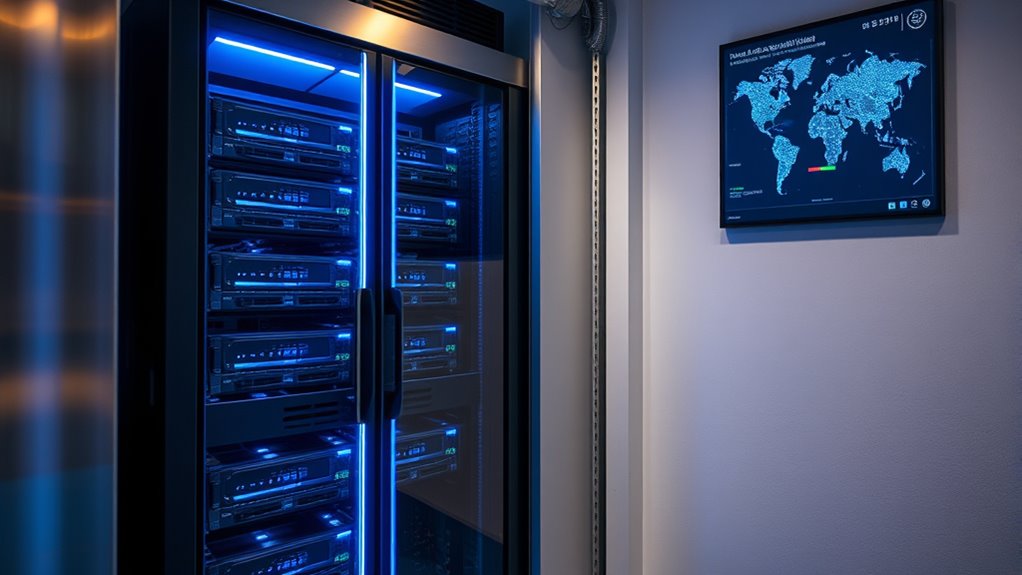Edge computing is quietly replacing traditional data centers by pushing processing closer to where you are—faster, more secure, and more reliable. Instead of sending data far away, edge devices handle it locally, reducing delays and risks of cyber threats. This shift improves your experience across streaming, smart devices, and industrial apps. By staying near you, edge solutions boost security and resilience. Keep exploring how this quiet revolution is reshaping your digital world.
Key Takeaways
- Edge computing processes data locally, reducing reliance on centralized data centers and decreasing latency for real-time applications.
- It enhances security by limiting data transmission and enabling local threat detection and response.
- Decentralized edge infrastructure offers increased resilience and reduces points of failure compared to traditional data centers.
- The proliferation of IoT devices drives demand for edge processing, diminishing the need for extensive data center infrastructure.
- Edge solutions are becoming more robust and standardized, gradually replacing traditional data centers for faster, more secure data management.

As technology advances, edge computing is increasingly stepping in to replace traditional data centers, offering faster processing and reduced latency. This shift is especially noticeable as more devices connect through the Internet of Things (IoT). With IoT integration becoming common in homes, businesses, and cities, data no longer needs to travel long distances to centralized data centers. Instead, processing occurs closer to the source, which means you get real-time insights and faster responses. This setup also reduces the load on core data centers, allowing them to handle more complex tasks without bottlenecks. As a user, you benefit from smoother experiences, whether it’s streaming, smart home automation, or industrial automation.
Edge computing brings faster, real-time processing closer to you, reducing latency and enhancing digital experiences across devices and smart environments.
Edge computing’s proximity to data sources enhances network security by limiting the exposure of sensitive information. Instead of transmitting all data over the internet to a remote data center, only relevant or aggregated data moves across networks. This minimizes the risk of interception or cyberattacks during transmission. Additionally, with edge devices managing initial data filtering and processing, you gain better control over what information is stored or shared, strengthening your overall security posture. Network security measures are built into the edge infrastructure, enabling faster threat detection and response. This means you’re less vulnerable to breaches, as threats can be identified and mitigated locally, often in real time. Incorporating security protocols at the edge further enhances protection by adapting to evolving cyber threats more rapidly. Moreover, the integration of cybersecurity measures at each edge node ensures comprehensive protection across the entire network.
The decentralization of data processing also means fewer points of failure. When data centers are spread out across multiple edge locations, a cyberattack or technical issue affects fewer users and systems. You experience fewer outages and disruptions, which is vital for critical services like healthcare, transportation, or emergency response. Furthermore, advancements in edge hardware are constantly improving the capabilities and robustness of these systems, ensuring more reliable performance. As more organizations adopt edge computing, security protocols are evolving to address new challenges, making it safer for you to rely on these systems. In addition, the ongoing development of standardized security frameworks helps ensure consistent protection across different devices and platforms. Additionally, increased focus on interoperability standards promotes seamless integration and security consistency across diverse edge environments.
In essence, edge computing is not just about faster data processing; it’s also reshaping how your data is protected and managed. IoT integration allows smarter, more responsive devices, while improved network security ensures your data stays safe. As edge infrastructure grows closer to you—whether in your neighborhood, workplace, or city—you’ll notice more seamless, secure digital experiences. This transformation is happening quietly but steadily, replacing traditional data centers with smarter, more resilient edge solutions that put speed and security at the forefront of your digital life.
Frequently Asked Questions
How Does Edge Computing Impact Data Privacy and Security?
Edge computing improves your data privacy and security by keeping data closer to its source, reducing exposure risks. You benefit from better data sovereignty because local processing guarantees compliance with regional regulations. Additionally, encryption standards are applied at the edge, safeguarding sensitive information during transmission and storage. This decentralized approach minimizes vulnerabilities, giving you more control over your data while enhancing security and privacy.
What Industries Benefit Most From Local Edge Computing Solutions?
You’ll find industries like smart manufacturing and healthcare innovation benefit most from local edge computing solutions. In manufacturing, edge computing enables real-time monitoring and faster decision-making, boosting efficiency. Healthcare providers use it to process patient data quickly, improving outcomes. These industries gain reduced latency, enhanced security, and greater reliability, making local edge solutions essential for their rapid, data-driven operations.
How Cost-Effective Is Deploying Edge Computing Compared to Traditional Data Centers?
Imagine building a small, local shed instead of renting a huge warehouse—that’s what deploying edge computing feels like. When you compare costs, you’ll find edge solutions often require lower initial investment and reduce ongoing expenses, making them more budget-friendly. For your business, this cost comparison means better resource allocation, especially if you need quick data processing. Edge computing can save money while meeting your specific needs effectively.
What Are the Main Challenges in Implementing Edge Computing Infrastructure?
You’ll face challenges in implementing edge computing infrastructure, especially around network architecture and hardware scalability. Building a reliable network that connects numerous edge devices requires careful planning to avoid bottlenecks. Plus, ensuring hardware scalability means choosing flexible solutions that can grow with your needs. You must also address security concerns and manage maintenance efficiently. Overcoming these hurdles is vital for a successful, resilient edge computing setup.
How Does Latency Reduction Improve User Experience With Edge Computing?
Reducing network latency with edge computing directly boosts your user experience by making interactions faster and more seamless. When data is processed closer to you, delays decrease, meaning your apps respond instantly, streaming is smooth, and real-time services work better. This immediate data handling minimizes lag, ensuring you enjoy more reliable, efficient performance. As a result, your overall satisfaction with digital services improves because the system feels quicker and more responsive.
Conclusion
So, as you can see, edge computing isn’t just a trend—it’s the dawn of a new era where data centers are moving closer to you. Think of it like planting a seed near your house instead of in a faraway field; things grow faster and more efficiently. Embrace this shift, because soon, your digital world will be more responsive—and just a little more personal—thanks to these quiet, powerful changes right at your doorstep.
Amina brings over a decade of journalism experience to her role as Editor-in-Chief. Under her leadership, Exquisite Post has flourished, maintaining the highest standards of integrity and excellence. Amina’s commitment to truth and her visionary approach guide the editorial team in producing impactful news stories that resonate with our audience.










